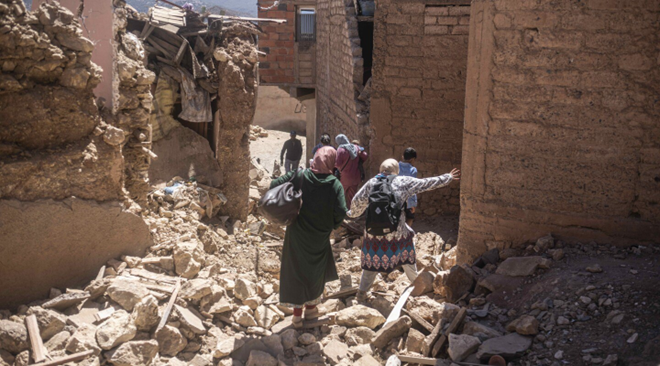
The September 8 powerful earthquake in Morocco has killed more than 2,000 people and damaged many historic buildings in Marrakech
A rare, powerful earthquake struck Morocco late Friday, 8 September, sending people racing from their beds into the streets and toppling buildings in mountainous villages and ancient cities not built to withstand such force. More than 2,000 people were killed, and the toll was expected to rise as rescuers struggled Saturday to reach hard-hit remote areas.
The magnitude 6.8 quake, the biggest to hit the North African country in 120 years, sent people fleeing their homes in terror and disbelief late Friday. One man said dishes and wall hangings began raining down, and people were knocked off their feet. The quake brought down walls made from stone and masonry, covering whole communities with rubble.
The devastation gripped each town along the High Atlas’ steep and winding switchbacks in similar ways: homes folding in on themselves and mothers and fathers crying as boys and helmet-clad police carried the dead through the streets.
Remote villages like those in the drought-stricken Ouargane Valley were largely cut off from the world when they lost electricity and cellphone service. By midday, people were outside mourning neighbors, surveying the damage on their camera phones and telling one another “May God save us.”
Hamid Idsalah, a 72-year-old mountain guide, said he and many others remained alive but had little future to look forward to. That was true in the short-term — with remnants of his kitchen reduced to dust — and in the long-term — where he and many others lack the financial means to rebound.
“I can’t reconstruct my home. I don’t know what I’ll do. Still, I’m alive, so I’ll wait,” he said as he walked through the desert oasis town overlooking red rock hills, packs of goats and a glistening salt lake. “I feel heartsick.”
In historic Marrakech, people could be seen on state TV clustering in the streets, afraid to go back inside buildings that might still be unstable. The city’s famous Koutoubia Mosque, built in the 12th century, was damaged, but the extent was not immediately clear. Its 69-meter (226-foot) minaret is known as the “roof of Marrakech.” Moroccans also posted videos showing damage to parts of the famous red walls that surround the old city, a UNESCO World Heritage site.
At least 2,012 people died in the quake, mostly in Marrakech and five provinces near the epicenter, Morocco’s Interior Ministry reported Saturday night. At least 2,059 more people were injured — 1,404 critically — the ministry said.
“The problem is that where destructive earthquakes are rare, buildings are simply not constructed robustly enough to cope with strong ground shaking, so many collapses, resulting in high casualties,” said Bill McGuire, professor emeritus of geophysical and climate hazards at University College London.
In a sign of the huge scale of the disaster, Morocco’s King Mohammed VI ordered the armed forces to mobilize specialized search and rescue teams and a surgical field hospital, according to a statement from the military.
The king said he would visit the hardest hit area Saturday, but despite an outpouring of offers of help from around the world, the Moroccan government had not formally asked for assistance, a step required before outside rescue crews could deploy.
The epicenter of Friday’s tremor was near the town of Ighil in Al Haouz Province, roughly 70 kilometers (44 miles) south of Marrakech. Al Haouz is known for scenic villages and valleys tucked in the High Atlas Mountains.
Police, emergency vehicles, and people fleeing in shared taxis spent hours traversing unpaved roads through the High Atlas in stop-and-go traffic, often exiting their cars to help clear giant boulders from routes known to be rugged and difficult long before Friday’s earthquake. In Ijjoukak, a village in the area surrounding Toubkal, North Africa’s tallest peak, residents estimated nearly 200 buildings had been leveled.
Couch cushions, electric cords, and grapes were strewn in giant piles of rubble alongside dead sheep, houseplants and doors wedged between boulders. Relatives from the town and those who had driven from major cities cried while they wondered who to call as they reckoned with the aftermath and a lack of food and water.
“It felt like a bomb went off,” 34-year-old Mohamed Messi said.
Morocco will observe three days of national mourning with flags at half-staff on all public facilities, the official news agency MAP reported.
World leaders offered to send in aid or rescue crews as condolences poured in from countries in Europe, the Middle East, and the Group of 20 summit in India. The president of Turkey, which lost tens of thousands of people in a massive earthquake earlier this year, was among those proposing assistance. France and Germany, with large populations of people of Moroccan origin, also offered to help, and the leaders of both Ukraine and Russia expressed support for Moroccans.
In an exceptional move, neighboring rival Algeria offered to open its airspace to allow eventual humanitarian aid or medical evacuation flights to travel to and from Morocco. Algeria closed the airspace when its government severed diplomatic ties with Morocco in 2021 over a series of issues. The countries have a decadeslong dispute involving the territory of Western Sahara.
The U.S. Geological Survey said the quake had a preliminary magnitude of 6.8 when it hit at 11:11 p.m. (22:11 GMT), with shaking that lasted several seconds. The U.S. agency reported a magnitude 4.9 aftershock hit 19 minutes later. The collision of the African and Eurasian tectonic plates occurred at a relatively shallow depth, which makes a quake more dangerous.
Earthquakes are relatively rare in North Africa. Lahcen Mhanni, Head of the Seismic Monitoring and Warning Department at the National Institute of Geophysics, told 2M TV that the earthquake was the strongest ever recorded in the region.
In 1960, a magnitude 5.8 tremor struck near the Moroccan city of Agadir and caused thousands of deaths. That quake prompted changes in construction rules in Morocco, but many buildings, especially rural homes, are not built to withstand such tremors.
In 2004, a 6.4 magnitude earthquake near the Mediterranean coastal city of Al Hoceima left more than 600 dead.
Friday’s quake was felt as far away as Portugal and Algeria, according to the Portuguese Institute for Sea and Atmosphere and Algeria’s Civil Defense agency, which oversees emergency response.
After quake
Terrified Moroccans spent a second night in the streets after a powerful earthquake killed more than 2,000 people, as rescuers race against time to reach trapped victims in remote mountain villages near the epicenter hit hardest by the devastating tremor.
The 6.8-magnitude quake, which struck late on Friday, was Morocco’s deadliest in six decades. It was also the strongest to hit the region around the ancient city of Marrakech in a century, according to the US Geological Survey.
So far 2,012 people have been listed killed and 1,404 others critically injured, according to Moroccan authorities, but the toll is expected to rise further as rescuers dig through the rubble of collapsed houses in remote areas of the High Atlas mountains.
In historic Marrakech, the largest city near the center of the quake and a major tourist draw, many families spent Saturday night staying out in the open, as authorities warned residents to pay close attention to follow-up tremors.
People stayed away from the damaged buildings in the city’s tightly-packed medieval-era center as well as the surrounding red earth walls, where parts have crumbled.
A Marrakech resident told CNN the walled old city, or medina, suffered extensive damage.
“There is a lot of damage that has happened to a lot of buildings. Some of them are mosques, some of them are houses, a lot of communities got hurt,” he said.
In the Oliveraie Park in central Marrakech, hundreds of people, including children and the elderly, slept on blankets and makeshift mattresses. Families huddled together, trying to get some rest after the shock and panic from the night before.
Some brought bags of clothes and food, preparing for a possible longer stay away from their homes.
Flags around the city are flying at half-mast to mark three days of national mourning announced by the monarchy.
In Marrakech’s airport, dozens of tourists slept on the floor in the main terminal, waiting to catch a flight out. Flights in and out of the tourism hub have been operating mostly as normal.
Morocco’s King Mohammed VI has issued instructions to set up a commission for relief services, which will provide care, housing and food for those affected.
Scenes of destruction and despair have also played out in villages dotting the foothills of the Atlas Mountains, where the quake was centered.
These remote areas had the highest number of fatalities, with homes made from mud bricks crumbling onto residents and boulders blocking roads for rescue teams to arrive.
Aerial footage showed villages perching on slopes flattened, reduced to piles of rubble in the aftermath of the quake.
Fatima, 50, told CNN her house in the mountain village of Asni had been destroyed.
“I barely got the chance to grab the kids and run out before I saw my house collapsing in front of my eyes. The neighbor’s house has also collapsed and there are two dead people under the rubble,” she said.
Mohammed, 50, from the nearby town of Ouirgane, lost four family members in the quake.
“I managed to get out safely with my two children but lost the rest. My house is gone,” he said.
“We are out in the streets with authorities as they try to pull the dead from the rubble. Many, many people were transported to hospital, in front of me. We are hoping for miracles from the rubble,” he said.
In the small town of Moulay Brahim, footage released by Reuters showed villagers digging through the rubble to pull out bodies.
Rescuers are racing against time. The first 72 hours after a quake are the most critical period for finding survivors, as the condition of people trapped and injured can quickly deteriorate beyond that window.
“They call it the ‘golden period’ because if you’re going to get people out from under the rubble, that’s the time to do it,” said Joe English, a spokesperson for the UN’s Children Fund, UNICEF.
“These towns and villages, they’re remote, they’re hard to reach…International support and solidarity is absolutely critical,” he added.
Leaders from around the world have extended their condolences to Morocco and offered international aid.
France activated an emergency aid funded by local governments, while Israel’s emergency services geared up to mobilize in Morocco.
The United Arab Emirates will establish an “air bridge” to deliver supplies, and Algeria reopened its airspace for humanitarian aid and medical flights despite having previously cut off diplomatic relations with Morocco. Turkey is also sending personnel and tents.
The World Health Organization said more than 300,000 people had been affected by the powerful tremors in Marrakech and surrounding areas.
Not since 2004 has the country seen a comparable disaster, when a 6.3-magnitude earthquake struck the port city of Al Hoceima, claiming around 630 lives.
Morocco’s worst earthquake of modern times was in 1960 near the western city of Agadir which killed at least 12,000 people.



